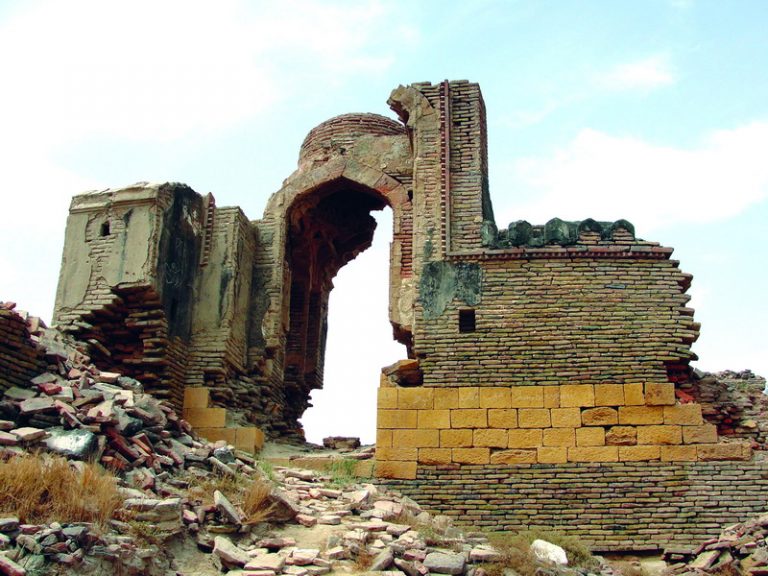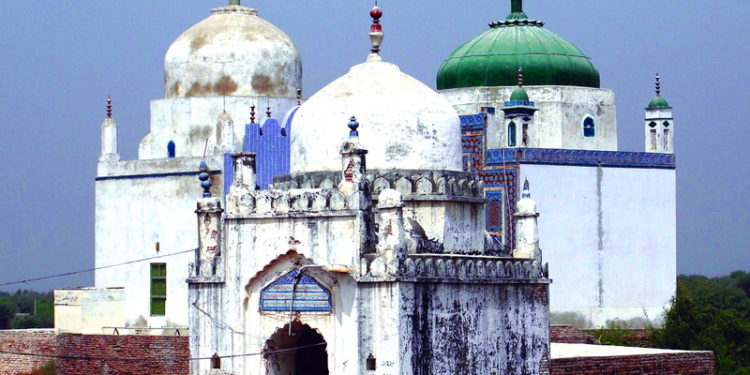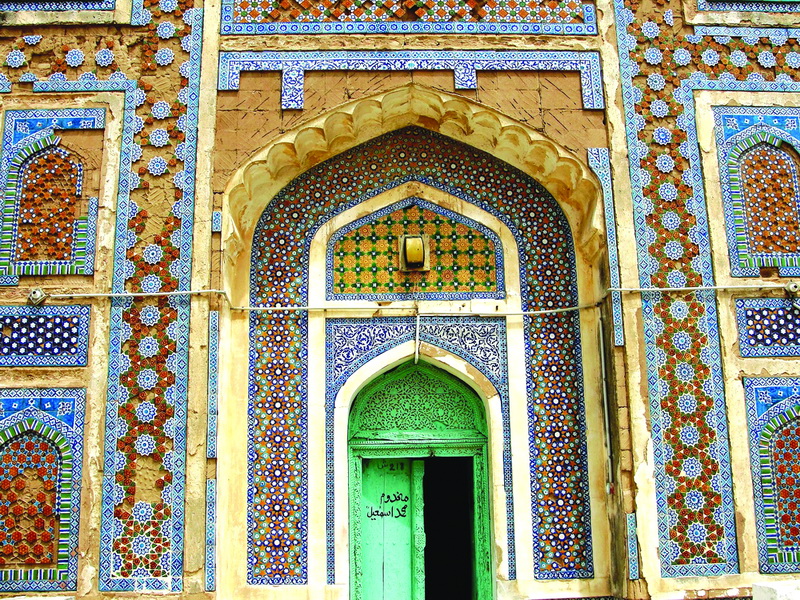
Thousands of graves and hundreds of madrasahs and tombs at Agham Kot or Aghamano are now a site of total ruin.
Zulfiqar Ali Kalhoro
Fraught with myths, folklores and legends, Agham Kot also called Aghamano, was believed to have been founded by Raja Agham Lohano. Agham Kot was a center of arts and culture in the 7th century and the urban landscape of the city was dominated by Buddhist stupas and Hindu temples. The Buddhists and the Brahmins were the two most influential communities at that time.
In the 8th century, the city was invaded by Arab armies and it became one of the prosperous and flourishing cities of Sindh in the subsequent centuries. From the 10th to the second half of the 14th century, it remained under the rule of the Soomra kings of Sindh. Later, the city witnessed the rise of mercantile and Muslim missionaries in the reigns of the Sammas, Arghuns, Tarkhans, Mughals and Kalhoras. The city lost its past glory when it was destroyed by the marauding army of Afghan invader Madad Khan in 1781 – who plundered and looted the city. After that pillage and plunder of the city by Madad Khan, the city could not recuperate its past glory and many people migrated to other parts of Sindh. Some Sindhi scholars believe that the splendour of city declined when the River Indus, which flowed near the city of Agham Kot, changed its course – which brought the trade of the city to a complete standstill, forcing the residents to migrate to other business centers in Sindh. Many migrated to Hyderabad, the then capital of Sindh founded by Ghulam Shah Kalhoro (1757-1772) and others to Thatta which was the cosmopolitan city of Sindh.
Whatever the reason for its destruction, today’s Agham Kot is nothing but a site of ruins where a kind of tranquility prevails. Agham Kot is located about 40 km south of Tando Allahyar. From a distance the ruins of Agham Kot rise up – the dazzling domes of tombs of the mystics and military officers of the Kalhora period (1700-1783) and remnants of walls and gates of the mosques. There are three remains of mosques, two of which were built during the Kalhora period. The most impressive and grand structure is that of the Jami mosque, as shown in the inscribed slab, which was built in 1755 during the reign of Mian Muradyab Kalhoro (1753-1757) and the stone engraver (sang-tarash) Abu Talib Makarpayo of Thatta engraved the foundation stones and dado of the mosque. Another mosque whose western wall and gate have survived was also built during the Kalhora period. The third mosque ‘Patanwari masjid’ (mosque of jetty), whose arches have only withstood the vagaries of weather was believed to have been built by Makhdoom Nasir Muhammad Bhatti of Hala.
Agham Kot is located about 40 km south of Tando Allahyar. From a distance the ruins of Agham Kot rise up – the dazzling domes of tombs of the mystics and military officers of the Kalhora period (1700-1783) and remnants of walls and gates of the mosques.

Apart from the mosques, the landscape of Agham Kot is dotted with the tombs and graves of mystics. The earliest tomb is said to be of Bibi Maham who settled in the city of Agam Kot during the Arab period. According to the inscription on her grave, she died in 170 AH/786. If one is to believe this date, then she is the earliest woman mystic of Sindh. But I believe that the caretakers of Bibi Maham’s shrine might have altered the date of her death from 1070 AH (1660 AD) or 1170 AH (1757 AD) to 170 AH (786 AD). Apparently this was done to attract more devotees. The earliest tomb at Agham Kot belongs to eminent mystic Makhdoom Muhammad Ismail Soomro who established his madrasah in the Samma period (1350-1524) and imparted religious education to the people. Hundreds of Sindhi Sufi saints and mystics are buried in Agham Kot, but unfortunately, the tombs and graves of those mystics have disappeared and are lost in the rubble of madrasahs, mosques, tombs and the fort which surrounded the city of Agham Kot.
It is believed that after Thatta, Agham Kot was the second largest city with hundreds of madrasahs where thousands of students from across the Islamicate world were studying during the Samma (1350-1524), Arghun (1524-1555), Tarkhan (1555-1592) and Kalhora (1700-1783) periods. Today, not a single madrasah has survived in Agham Kot. Only the tombs of Sufi saints are well maintained. The tomb of Makhdoom Muhammad Ismail Soomro (died in 1588) is accessed through a monumental gate which is crowned with a dome. The monumental gate bears the Persian inscription with the date of death of Makhdoom Muhammad Ismail Soomro as 996 AH/1588 AD.
The tomb of Makhdoom Muhammad Ismail Soomro is noted for the beautiful ceramic tiles which adorn its entire facade but unfortunately, a majority of them have come off. The interior of the tomb was also adorned with paintings but frequent renovations have damaged the painting. However traces of that original work can still be seen on the western wall of the tomb. There are four graves in the tomb which belong to Makhdoom Muhammad Ismail Soomro, his sons Makhdoom Muhammad Hamid, Makhdoom Muhammad Yahya and grandson Makhdoom Muhammad Qasim.

Makhdoom Muhammad Ismail Soomro was a celebrated saint of 16th -century Sindh. He used to buy grain from the landlords of the nearby village and stored it in his granary. He used to distribute this grain amongst the needy and the poor. Makhdoom Muhammad Ismail Soomro converted many Hindus to Islam. The father of Watayo Faqir, Molraj Khatri was converted by Makhdoom Muhammad Ismail Soomro. Both of his sons Ilyas and Watayo studied in the madrasah of Makhdoom Muhammad Ismail Soomro. Ilyas became Hafiz and Alim whereas Watayo wandered in the wilderness and became a Faqir and dervish. He was known for his wisecracks and was the equivalent of Mulla Nasruddin of Central Asia. The house of Watayo was located in Agham Kot and people recognized his abode by a large tree close to his house at that time. Nowadays, that place is referred to as ‘Wataiwaro Kando’( The tree of Watayo). The grave of Watayo is located near the town of Tando Allahyar.
Near the tomb of Makhdoom Muhammad Ismail Soomro is located his one-domed mosque which is believed to have been built by him during his lifetime. East of this mosque is located the tomb of Shah Mahmood Jilani who was also known for his piety. Towards the eastern most part is the tomb of Shah Abdul Majid who is believed to be from the family of Baba Farid Ganj Shakar (1179 -1266). The old tomb of Shah Abdul Majid collapsed many years ago and the new tomb was built by his Hindu Lohana devotee. Shah Abdul Majid is the patron saint of Hindu Lohanas. To the north of the tomb of Makhdoom Muhammad Ismail Soomro is located the tomb of his daughter Bibi Ayesha. To the east of this structure are two tombs of Makhdoom Muhammad Ismail Quraishi, a disciple of Makhdoom Muhammad Ismail Soomro and Saeed Khan Madvani Laghari.
Saeed Khan Madvani Laghari was a military officer in the army of Mian Noor Muhammad Kalhoro (1719-1753).
Thousands of graves and hundreds of madrasahs and tombs at Agham Kot or Aghamano are now a site of a total ruin. The surviving tombs of both male and female mystics are frequented by people not only of Badin but also of other districts of Sindh.
Although the shrine of Mahdoom Muhammad Ismail Soomro is frequented by people of many castes he is popularly known as the patron saint of the Patoli community – much like Shah Abdul Majid who is the patron saint of Hindu Lohanas.
__________________
 Dr. Zulfqar Ali Kalhoro, an anthropologist, has authored 12 books including ‘Symbols in Stone: The Rock Art of Sindh’, ‘Perspectives on the art and architecture of Sindh’, ‘Memorial Stones: Tharparkar’ and ‘Archaeology, Religion and Art in Sindh’. He may be contacted at: zulfi04@hotmail.com
Dr. Zulfqar Ali Kalhoro, an anthropologist, has authored 12 books including ‘Symbols in Stone: The Rock Art of Sindh’, ‘Perspectives on the art and architecture of Sindh’, ‘Memorial Stones: Tharparkar’ and ‘Archaeology, Religion and Art in Sindh’. He may be contacted at: zulfi04@hotmail.com
Courtesy: The Friday Times Lahore